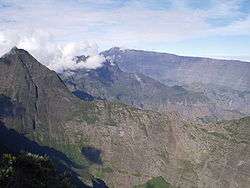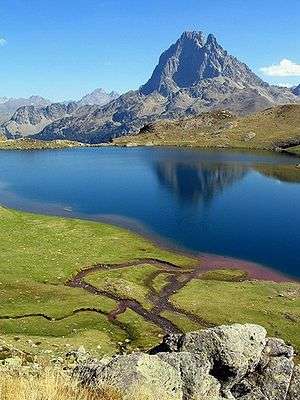Réunion National Park
| Réunion National Park | |
|---|---|
|
IUCN category II (national park) | |
|
Voile de la Mariée (Salazie) | |
 | |
| Location |
Réunion (France) Western Indian Ocean |
| Nearest city | Saint-Denis |
| Coordinates | 21°09′00″S 55°30′00″E / 21.15000°S 55.50000°ECoordinates: 21°09′00″S 55°30′00″E / 21.15000°S 55.50000°E |
| Area |
1,053.84 km2 (406.89 sq mi) (core area), 876.96 km2 (338.60 sq mi) (maximum integrated area)[1]:12 |
| Established | 2007 |
| Governing body | Parcs nationaux de France |
| Parc national de la Réunion (French) | |
Réunion National Park (French: Parc national de La Réunion) is a national park on the island of Réunion, an overseas department of France located in the western Indian Ocean region. Established on 5 March 2007, the park protects the endemic ecosystems of Les Hauts, Réunion's mountainous interior, and covers around 42% of the island. Notable endemic species include the Réunion cuckooshrike and the Reunion Island day gecko.
Plans for a park date back to 1985, and in a public survey in 2004, the communes of Réunion approved of creating a national park. The park's volcanic landscape, including the Piton de la Fournaise, an active volcano, was designated a World Heritage Site in 2010, under the name "Pitons, cirques and remparts of Reunion Island". The park's mission, other than preserving landscape and biodiversity, is to share knowledge and welcome visitors, and to work together with local communes. It is a popular destination for hiking and alpinism.
In 2016, the Regional Council of Réunion had plans to downgrade the national park to a regional nature park. This was contested by the park authorities and politicians from the opposition.
History
Planning phase
.jpg)
Proposals to create a park were first raised beginning in 1985. The Réunionnais Environmental Charter and the Regional Development Plan formally established the principle that a park should be created in Les Hauts. The French Ministry of the Environment was officially asked for the creation of a national park.[2]
Between 2000 and 2003, a consultation process was launched, in which the state, the region, the département, and the association of mayors agreed on a protocol and established a steering committee. 27 of 29 institutions endorsed the plan of establishing a national park, and on 29 March 2003, the French Prime Minister signed a decree acknowledging the project.[2]
Debates and negotiations on the limits and objectives of the future national park intensified. Between August and September 2004, the plan was the subject of a public survey, organised by the prefect in the 24 communes of the island. The communes responded positively to the project, adding some recommendations.[2]
Official creation
The park officially came into existence on 5 March 2007 through a decree taken after advice by the Council of State.[3] In April 2007, the Administration Council took office, between 2007 and 2009 personnel were employed and installations made on the site, and in 2008, work began to set up the charter of the national park.[2]
World Heritage designation
| Pitons, cirques and remparts of Reunion Island | |
|---|---|
| Name as inscribed on the World Heritage List | |
|
View from La Roche Écrite | |
| Type | Natural |
| Criteria | vii, x |
| Reference | 1317 |
| UNESCO region | Africa |
| Inscription history | |
| Inscription | 2010 (34th Session) |
On 1 August 2010, the UNESCO World Heritage committee in its assembly at Brasilia acknowledged the value of the natural sites within Réunion National Park, and includes the "Pitons, cirques and remparts of Reunion Island" in its World Heritage list.[2]
Debate on management and future
Since the park's creation, debates have arisen on its management and the effects on the population of Les Hauts. Inhabitants of the area have criticised that their history and traditions were not respected, with notably farming activities banned repeatedly while the park authorities said that every activity is possible, under certain conditions.[4]
On 13 September 2016, the national park's director, Marylène Hoarau, announced her withdrawal. The park's president, Daniel Gonthier, suspected political interference: Hoarau had criticised Didier Robert, président of the regional council, for launching a call for proposals on the future of the park, notably aiming at turning the national park into a regional nature park.[5]
Didier Robert denied involvement in Hoarau's departure. He defends his project of downgrading the national park to a regional park, stating that "the Réunion territories are deprived of even the smallest development because of too stringent rules" and that he does not want to ask for the park's permission for every planned activity. A regional park would provide more flexibility for economic activities. Park officials and regional opposition politicians denounced the plan, saying it would threaten the island's biodiversity and one of its major tourist attractions. It would be the first case of a national park in France to be downgraded.[6]
Mission
In its charter, the national park identifies four great objectives:[1]:3 First, to preserve the diversity of landscapes and accompany their evolution. Second, to inverse the loss of biodiversity. Third, to preserve and add value to the culture of the highlands and ensure the transmission of its values. Fourth, to foster economic development for the highland.
Geography

The core of Réunion National Park covers 1,053.84 km2 (406.89 sq mi) in the interior of the island, corresponding to 42% of it's surface and extending over the land of 23 communes. This core area also includes some inhabited and cultivated land. Adjacent to the core is an area of voluntary commitment (aire maximale d'adhésion) covering 876.96 km2 (338.60 sq mi) and touching all 24 communes on th island. Altogether, the park extends over more than 75% of the island.[1]:12 The region is mountainous, resulting from volcanic activity. Two main massifs form its backbone: The Piton des Neiges, over 3,000 m (9,800 ft) high, and the Piton de la Fournaise, the latter still an active volcano.[7]
Four major areas form the heart of the National Park, listed as World Heritage Site:[7]
- Mare Longue forest (also known as Forêts de bois de couleurs des Bas) at Saint-Philippe, including some of the best-preseved remains of low-altitude tropical forest;
- the Cirque de Cilaos with the Pain de Sucre and La chapelle, in the narrow gorge ot the Bras Rouge River, with a 100,000-year-old accessible magma chamber;
- the Cirque de Salazie with the Piton d'Anchaing, a 1,356 m (4,449 ft) high dominant massif;
- Grande Chaloupe between Saint-Denis and La Possession, one of the last remainders of the semi-evergreen forest once common in the west of the island, preserved and restored here.
Wildlife
Réunion shares a common natural history with the other Mascarene Islands, Mauritius and Rodrigues. All three islands have been uninhabited before the 1600s. Human arrival led to massive extinction, and introduced species, such as giant land snails (Achatina) in Réunion, threaten native habitats and species. Less than 25% of Réunion is thought to be covered with original vegetation, mostly restricted to higher altitudes. The forests of Réunion and the other two islands have been classified by the World Wildlife Fund as the Mascarene Forests ecoregion, with a conservation status of "endangered".[8] Conservation International includes Réunion in the Madagascar and Indian Ocean Islands biodiversity hotspot, a priority area for conservation.[9]
The isolation of the island and its diversity of habitats and microclimates have favoured the diversification of a highly endemic flora: Of the 850 known native plant species, 230 are endemic, and half af those are endangered. This native flora is found at various altitudes. Nearly as many exotic plants as native ones, 830, have become naturalised on the island, and 50 are considered invasive, threatening native flora and habitats.[10]
The park's fauna includes notably several endemic bird species, such as Barau's petrel, the Réunion harrier, and the Réunion cuckooshrike. In total, 18 bird species are found at Réunion, of which half are endemic. 22 bird species have gone extinct since human colonisation. A major threat to the bird fauna are cats and rats, introduced to the island. Of mammals, the Mauritian flying fox has recolonised the island. Notable butterfly species include Papilio phorbanta and Salamis augustina, and an endemic reptile is the Reunion Island day gecko.[11]
Tourism
The national park constitutes one of Réunion's major attractions. Its mountains are a popular destination for hiking and alpinism; there are more than 900 km (560 mi) of marked trails, crossing such different landscapes as rain forests, sugar cane plantations and volcanic fields. They include three long-distance trails endorsed by the French Hiking Federation, with mountain lodges along the trail. More than 400,000 people each year visit the Piton de la Fournaise volcano, for which a discovery trail has been established.[12]
The park's visitor's centre, La Maison du Parc at La Plaine-des-Palmistes, was inaugurated on 21 August 2014 by French President François Hollande.[7]
Management
Budget and structure
The park began with a budget of €2 million in its first year. As its activities expand, the budget is slated to progressively increase to €8 million. Park headquarters is at La Plaine-des-Palmistes.
The park is governed by an administrative council composed of 88 members. The administrative council elects 15 from among its members to serve as an executive committee. They are advised by a scientific council composed of 18 members and 5 outside experts. Plans additionally call for the creation of an economic, social, and cultural council.
Management issues
The park administration has supported exploration for geothermal power sources on the Plaine des Sables, against the advice of the scientific council and despite the fact that the park may soon be proposed as a World Heritage Site.
Notes and references
- 1 2 3 Bénard, J.-F.; Braun, E.; Duchemann, C.; Fontaine, I.; Gombert, S.; Maillot, I. (2013). Hoarau, M., ed. "La Charte du parc national de La Réunion – Les Pitons, cirques et remparts au centre d'un projet de territoire" (PDF) (in French). Plaine des Palmistes: Parc national de La Réunion. Retrieved 2016-11-27.
- 1 2 3 4 5 "Parc National de la Réunion – Historique" (in French). La Plaine-des-Palmistes: Parc National de la Réunion. 2008-07-07. Retrieved 2016-11-23.
- ↑ Décret n° 2007-296 du 5 mars 2007 créant le Parc national de la Réunion, Act No. 2007-296 of 2007-05-03 (in French). Retrieved on 2008-04-06.
- ↑ Floch, F. (2013-04-13). "Ile de La Réunion : le parc National autorise tout, mais…". Réunion La 1ère (in French). Retrieved 2016-11-23.
- ↑ IPR (2016-09-27). "Daniel Gonthier: Didier Robert a "ouvert un trou de souris", Ségolène Royal s'y est engouffrée". Imaz Press Réunion (in French). Saint-Denis. Retrieved 2016-11-23.
- ↑ Massemin, E. (2016-11-18). "Le Parc national de La Réunion menacé de déclassement". Reporterre (in French). Retrieved 2016-11-23.
- 1 2 3 "Reunion National Park". Saint-Paul: Ile de la Reunion Tourisme. 2016. Retrieved 2016-11-23.
- ↑ Schipper, J. (2004). "28 – Mascarene Forests". In Burgess, N.; D'Amico Hales, J.; Underwood, E.; et al. Terrestrial Ecoregions of Africa and Madagascar: A Conservation Assessment. World Wildlife Fund Ecoregion Assessments (2nd ed.). Washington D.C.: Island Press. pp. 267–269. ISBN 978-1559633642. Archived from the original (PDF) on 2016-11-01.
- ↑ Conservation International - Madagascar (2014). "Ecosystem Profile: Madagascar and Indian Ocean Islands" (PDF). Critical Ecosystem Partnership Fund. Retrieved 2016-11-24.
- ↑ "Parc National de la Réunion – Flore" (in French). La Plaine-des-Palmistes: Parc National de la Réunion. 2008-07-07. Retrieved 2016-11-23.
- ↑ "Parc National de la Réunion – Faune" (in French). La Plaine-des-Palmistes: Parc National de la Réunion. 2008-07-07. Retrieved 2016-11-23.
- ↑ "Hiking on the island". Saint-Paul: Ile de la Reunion Tourisme. 2016. Retrieved 2016-11-23.

